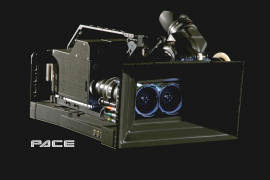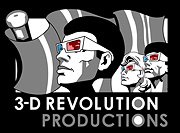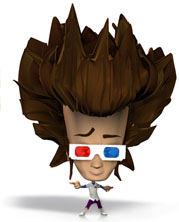3-D Stereoscopic Post Production

An optical Printer - nowadays replaced by D.I. and digital magic
3-D Stereoscopic Post Production. The words strike fear into most Post facilities’ hearts. It is not surprising, as there are two major factors that determine a 3-D pipeline;
First and foremost you will need to truly understand 3-D to be able to do Post for it. Luckily, knowledge can be brought in by means of getting a 3-D consultant (aka a stereographer) involved in the (Post) Production process.
Twin HD shooting - two HD
streams to deal with
The hands-on side of 3-D postproduction is more demanding – and a lot more expensive. Editing is already a big leap from plain old flat 2-D to 3-D, with its requirements of slower cuts, convergence and interaxial matching from shot to shot and overall z-depth eye-guiding within the frame. But doing effects, colour correction, grading, geometric distortion correction, and playing it all back in 3-D is a very different game altogether. Of course, there is the issue of needing to be able to process and play back two streams of 2K or 4K D.I. or HD material, preferably without hiccups – as frame drops introduce out of sync 3-D, which is not only unwatchable, it is purpose defeating to the whole process of 3-D stereoscopic Posting.
The Quantel Pablo with 3-D Stereoscopic Editing capabilities
This is where very recent arrivals on the stereoscopic playing field come into play. Quantel suggests a 3-D solution that works with their ‘Pablo’, ‘iQ’ and ‘Max’ system. With the ability to play back 2 streams of 2k (1920p) material (or 1 stream of 4k material), it fits the bill for quick, rough 3-D editing and 3-D conforming. A few tools are introduced that allow for getting the two video streams in sync, both time- and colour/exposure-wise, while allowing for touch-up painting to get rid of nasty 3-D inequality like reflections, lens flares, scratches and other retinal rivalry-inducing artefacts. Besides offering rudimentary image distortion correction. The beauty is that it is all real-time and render-free. The choice of 3-D output is left up to the user, with two independent SDI / DVI streams coming out of the Pablo. So that can be anything from a field/frame sequential solution like CrystalEyes, plain old Anaglyph previewing or full-blown twin-projector polarized projection.
The Quantel Pablo 3-D interdace with Ghost of the Abyss under the 3-D knife
A very similar solution has been released by Assimilate within the ‘Scratch’ solution. This product boasts 2x 4k stream processing with all the horns and bells of the Quantel box, but with a similar price tag and running on Boxx PC hardware, not custom Quantel stuff. That price tag lies round about 70k in Pounds Sterling, but that is a price that would be incurred with a D.I.Y. approach with Boxx-like PC or Octo-Core PowerMac hardware as well, while frame stability is guaranteed in Scratch and Pablo, versus not-so-certain perfect playback in the D.I.Y. solutions.
Assimilate Scratch 3-D Stereoscopic Post Solution
It is certainly good to know there are working tools available to correct simple 3-D camera problems, but it is imminently preferable to shoot it all properly and trouble free in the first place. Quantel’s showreel contained a lot of Pace material, shot by Vincent Pace and James Cameron with the ‘Reality Camera System’, now renamed to ‘Fusion 3-D’. Pretty much every shot in that reel uses converging cameras, large interaxials, wide-angle lenses and fast camera moves. These clips are labelled (and considered) state-of-the art 3-D HD material, but by nature they are headache-inducing, poorly executed 3-D shots. Not exactly the ambassadors of 3-D film and television one would ideally want.
The Pace Fusion 3-D Camera
We’re not being negative about big names in 3-D image acquisition for the sake of it here, we’re trying to say that it’s time to look past the glib and to start really, closely looking at 3-D material to realize what is good 3-D and what is just not acceptable as a professional standard. Unless you are happy to correct every frame in post or leaving your audience with a big hangover from watching your 3-D film and television show, that is. If you are going to shoot in 3-D, you will have to use its own particular language, its unique pace, its different compositions. Respect the medium or discomfort your audience – just like with colour and sound, where too loud, all the time, is just not an experience people will walk away from with pleasant memories and smiles on their faces.![]()
![]()
![]()
![]()
![]()
![]()
![]()
![]()
![]()
![]()
![]()
![]()




